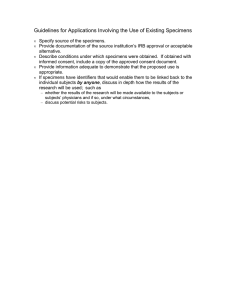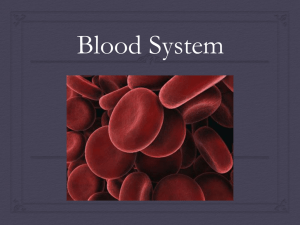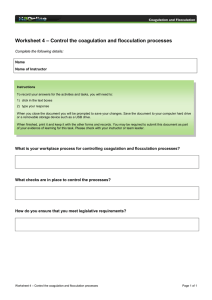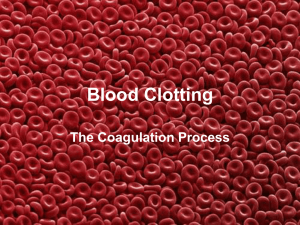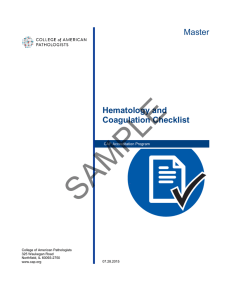COAGULATION PRECEPTORSHIP OBJECTIVES Purpose
advertisement
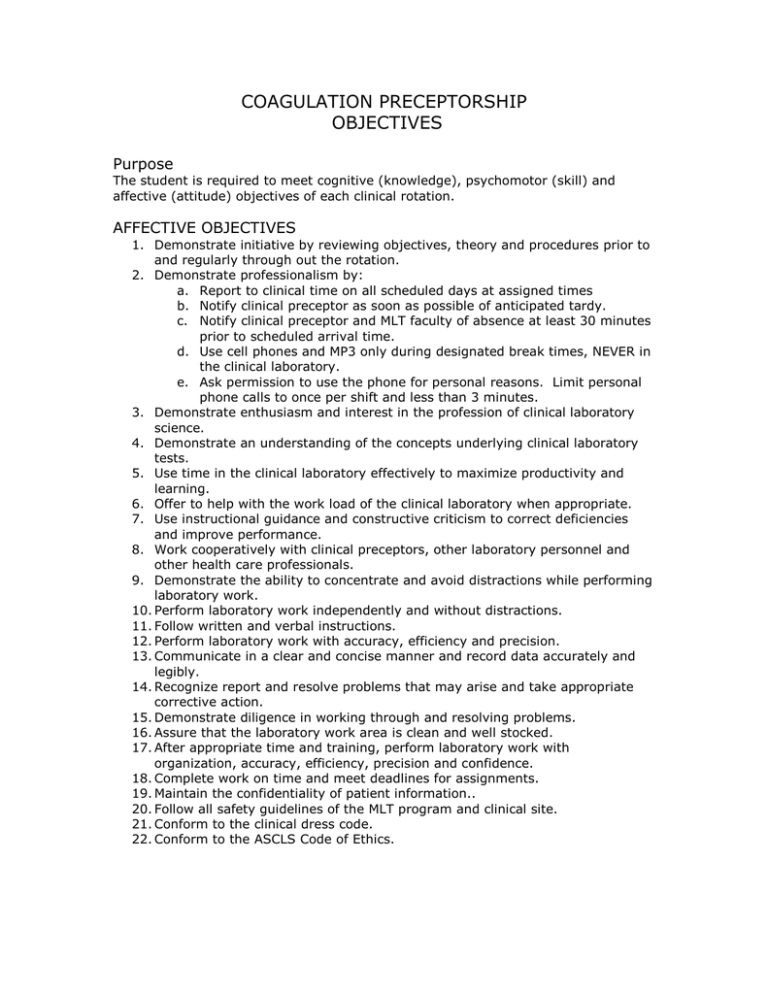
COAGULATION PRECEPTORSHIP OBJECTIVES Purpose The student is required to meet cognitive (knowledge), psychomotor (skill) and affective (attitude) objectives of each clinical rotation. AFFECTIVE OBJECTIVES 1. Demonstrate initiative by reviewing objectives, theory and procedures prior to and regularly through out the rotation. 2. Demonstrate professionalism by: a. Report to clinical time on all scheduled days at assigned times b. Notify clinical preceptor as soon as possible of anticipated tardy. c. Notify clinical preceptor and MLT faculty of absence at least 30 minutes prior to scheduled arrival time. d. Use cell phones and MP3 only during designated break times, NEVER in the clinical laboratory. e. Ask permission to use the phone for personal reasons. Limit personal phone calls to once per shift and less than 3 minutes. 3. Demonstrate enthusiasm and interest in the profession of clinical laboratory science. 4. Demonstrate an understanding of the concepts underlying clinical laboratory tests. 5. Use time in the clinical laboratory effectively to maximize productivity and learning. 6. Offer to help with the work load of the clinical laboratory when appropriate. 7. Use instructional guidance and constructive criticism to correct deficiencies and improve performance. 8. Work cooperatively with clinical preceptors, other laboratory personnel and other health care professionals. 9. Demonstrate the ability to concentrate and avoid distractions while performing laboratory work. 10. Perform laboratory work independently and without distractions. 11. Follow written and verbal instructions. 12. Perform laboratory work with accuracy, efficiency and precision. 13. Communicate in a clear and concise manner and record data accurately and legibly. 14. Recognize report and resolve problems that may arise and take appropriate corrective action. 15. Demonstrate diligence in working through and resolving problems. 16. Assure that the laboratory work area is clean and well stocked. 17. After appropriate time and training, perform laboratory work with organization, accuracy, efficiency, precision and confidence. 18. Complete work on time and meet deadlines for assignments. 19. Maintain the confidentiality of patient information.. 20. Follow all safety guidelines of the MLT program and clinical site. 21. Conform to the clinical dress code. 22. Conform to the ASCLS Code of Ethics. PSYCHOMOTOR AND COGNITIVE Safety 1. Use appropriate personal protective equipment at all times when working with patient samples. 2. Locate all fire extinguishers, eye wash stations and safety showers. 3. Locate Materials Safety Data Sheets, chemicals carcinogens list, and hazardous chemicals list. Specimen Preparation 1. Recognize unacceptable specimens and follow procedures required when such specimens are received. 2. Collect or recognize and process without assistance appropriate specimens for testing. 3. Separate, aliquot, label and distribute specimen according to laboratory standard operating procedure (SOP). 4. Organize patient workload and manage time to complete task assignments in specific time allowed. 5. Apply requirements for proper specimen collection and preservation to sample processing. 6. Dilute specimens, repeat analysis and calculate true result for all procedures performed as required. Reference Laboratory Send-Out 1. Using reference laboratory procedure manuals, process specimens for transport. Quality Assurance 1. Accurately and legibly log in and maintain required records at all times. 2. Pipette accurately at all times. 3. Reconstitute control sera and standards with accuracy and reliability without direct supervision. 4. Perform quality assurance procedures for each test analysis and consistently maintain required documentation. 5. Evaluate quality control data, recognize out-of-control data and perform troubleshooting measures according to laboratory policies for all laboratory procedures. 6. Apply Westgard rules to quality control decisions, recognize out-of-control situations, and perform actions outlined in the SOP when these situations occur. 7. Determine and implement the course of action to be taken when delta checks are not correlated. 8. Recognize test results that need to be checked by repeat testing and those that are beyond the limits of linearity and perform procedures as defined by SOP when these occur. Reference Ranges and Clinical Significance 1. Recognize reference ranges, therapeutic ranges, and critical values and perform procedures at all times that are required by the SOP when these occur. 2. Differentiate normal from abnormal coagulation results correlating abnormal values and associated disease states. Routine Daily Activities 1. Perform clerical work including test logs, recording and reporting laboratory results with 95% accuracy. 2. Properly prepare reagents, calibrators, standards and controls for daily use [where appropriate] a. Recognize acceptability: expiration date, labeling, appearance, contamination b. Select correct pipette and use correctly 3. Perform daily calibration and maintenance checks on coagulation instruments with 95% accuracy. 4. Operate automated or semi-automated analyzers utilizing appropriate quality control and obtaining reportable results. a. Assemble reagents, standards, calibrators and controls b. Prepare instrument for use c. Verify that instrument is operating properly. 5. Prepare specimens for use in coagulation procedures, evaluating suitability for tests ordered: a. Prioritize samples based on urgency of test requests. b. Correctly identifies patient sample. c. Assessing adequacy of sample for tests ordered. d. Properly storing samples before and after testing. e. Determine the affects of hemolysis, lipemia and clots on results. f. Identifies pre-analytical errors which will interfere with specific tests, i.e., high hematocrits, incorrect tube additive, etc. 6. Recognize and act upon out-of-control results according to established laboratory protocol. 7. Identify abnormal, out of range or panic values and take appropriate action. 8. Prepare specimens for shipment to reference laboratories. 9. Perform coagulation procedures including daily start-up, calibration and quality control procedures. a. Correctly follow written procedure. b. Maintaining controls within +/- 2 standard deviations. 10. Discuss the basic concepts of clot detection for the instrument(s) used in the rotation. 11. Differentiate between internal and external quality control programs discussing the applications of each. AUTOMATION 1. State the principle of operation and method of clot detection for the instrument(s) utilized in the laboratory in which you are rotating. 2. Compare and contrast optical vs. elctromechanical methods for clot detection. 3. For each of the tests listed below, perform/describe (NOTE: as appropriate for the rotation laboratory) the procedure, including reagent and control preparation, state the normal range and panic values, and describe the portion of the hemostatic mechanism being tested: Prothrombin time Activated partial thromboplastin time Fibrinogen FDP D-dimer Factor assays Mixing/correction studies Bleeding time Platelet aggregation studies 4. Observe/perform maintenance on the primary coagulation instrument. 5. Given an error code or common instrument malfunction, find the appropriate trouble-shooting information and discuss the action to be taken. GENERAL KNOWLEDGE 1. Draw the coagulation cascade, showing the relationship of each of the coagulation factors, the cofactors, and other substances required for the reactions to occur optimally. 2. Calculate the INR, given the appropriate data. 3. Discuss the purpose, reference and therapeutic value of the INR. 4. List the coagulation studies used to assess a bleeding disorder, state the principle of the test and the part of the hemostatic mechanism being tested. 5. Correlate results of tests with disease states or disorders.

